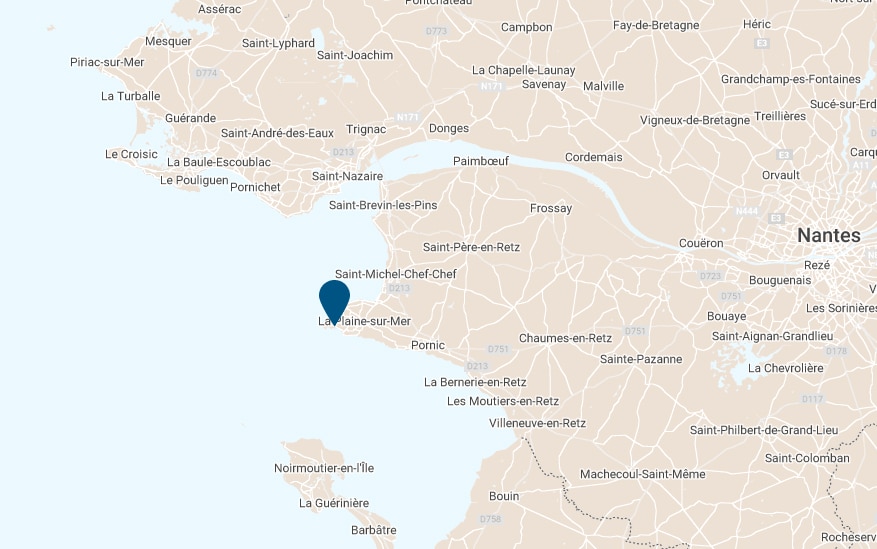
Pornic: a treasure trove of discoveries just a few minutes from the campsite
Located on the shores of the Atlantic Ocean, Pornic is a town in the Loire-Atlantique department of western France. Having merged with Le Clion-sur-Mer and then with Sainte-Marie-sur-Mer, the town enjoys an oceanic climate. With a soil formation dating back over 500 million years, it is immersed in the south of the Brittany trench. Here’s what you need to know about Pornic’s history and tourist attractions.
Stay at our campsite located 11 km from Pornic and discover all that makes this town so charming.
What to do in Pornic during the vacations
Pornic offers many activities to help you relax and make the most of your vacation, such as :
- Fishing in Pornic;
- The casino, the golf course, the thalasso;
- The castle;
- All the beaches of Pornic;
- Pornic’s ports ;
- Les Salines de Millac;
- The Josselière or Prédaire dolmen.
- Zoo Planète Sauvage.
Pornic: its history
Several dates have marked the evolution of the commune since its origins.
Prehistoric times in Pornic
To tell thestory of Pornic, it’s important to go back to prehistoric times. It was during this period that the first life forms appeared on earth. By 5000 BC, the cliffs of Sainte-Marie were already occupied by prehistoric man. At that time, we were talking about Late Mesolithic man.
Neolithic man then proceeded to build megalithic monuments between 4000 and 3500 BC. J-C. Among the monuments published, the best-known is the Mousseaux tumulus. Several years later, the Romans, accompanied by their king, moved close to the town and attached it to Aquitaine. It was the year 56 BC.
Pornic’s Middle Ages
Pornic’s ancient period began with the birth of the first community, which settled on Clion-sur-Mer and took the name of Vicus. This was during the period 600-700 AD. The following year, the first monks’ church was built. It was built in Sainte Marie by the monks of Saint Philbert.
In 712, the Sarassins arrived in the bay, followed by the Vikings in 799. The century that followed saw a succession of events. First, the county of Herbauges took over the Pornic region. Then it was Erispoé’s turn to take over the Pays de Retz. Alain Barbetote’s Viking hunt continued for over a decade. This pursuit took place between 937 and 942, a period during which castles were built. This event gradually marked the birth of Pornic.
At the beginning of the 11th century, the church of Sainte Marie was left in the care of the monks of Saint-Sauveur-de-Redon. The name of the town of Pornic first appeared in the archives in 1083. In the century that followed, the town’s economy began to grow, thanks in particular to the tide mills on the causeway. In the 20 years between 1150 and 1170, the Sainte Marie foundation welcomed the Augustinians from Saint Médard de Doulon. Then, in 1183, the first districts of Sainte Marie came into being and the town joined forces with Pornic.
During the 14th century, the Bay of Brittany came under English control. The Pays de Retz under Girard IV Chabot was governed by an English captain, while Pornic came under the authority of the Duke of Brittany. In 1399, Pornic was once again under the reign of Jeanne de Rais, daughter of Girard Chabot. Several other key dates marked this period in Pornic’s history.
Modern and contemporary Pornic
In 1548, Pornic appeared on a map of the Breton coast. During the same century, Pornic was seized by the League, and the town’s economy began to plummet the following century. Indeed, pirates stormed the town at the beginning of the century, pillaging three ships in 1617. Pornic became a privateer port, one of the most important in the sub-region where triangular trade was developing.
Centuries, years and events followed one another until 1973, when Sanmaritains, Clionnais and Pornicais merged to form a single commune. Pornic is now the name that will be retained from this merger, following a prefectoral decree.
Pornic: tourism and culture
The commune of Pornic is also a land with its own culture, where tourism thrives. Several tourist sites have sprung up in the city, making it an exciting place to visit. Pornic is an excellent destination for a vacation or a pleasant stay.
Renowned for its many castles built in historic times, it also boasts a large flora and fauna reserve. You’ll be amazed not only by the landscape, but also by the beaches and proximity to the sea. Here are just a few of the activities you can enjoy in this city.
Leisure activities in Pornic
Discover the “sentier des douaniers”, a genuine natural area where you can go for a walk. Whether you’re on bike, foot or horseback, you can take a stroll through this park, which runs alongside critical areas and rocky cliffs.
Pornic and the surrounding area offer many walks and hikes:
- Discover downtown Pornic ;
- La Vélodyssée for cycling tours
- The GR 34 customs trail;
- The Sainte-Marie circuit: 8.3 km
- Huchepie circuit: 14.6 km
- Hauts Prés circuit: 15.7 km
- Circuit le canal de haute perche: 11.3 km
- Pornic and the Gourmalon district: 3 km
- The fisheries circuit: 11km – 2h45 on foot
You can also take advantage of this natural environment and go fishing in the sea, in ponds, etc. You can also have fun swimming in the sea at beaches or in swimming pools. You can also take part in a range of sporting activities. Activities include water sports and fitness in one of the parks. Take a boat trip to discover Pornic’s many beaches, including :
- la Joselière beach,
- la plage de l’Étang,
- la plage des sablons,
- Fontaine aux Bretons beach,
- La Briochère beach, etc.
Apart from these leisure venues, you can also take a trip to the Môle casino if you’re a gambling fan. Visit the various monuments and natural sites such as the Bay of Bourgneuf. Let Pornic’s Tourist Office take you on a guided tour to enjoy even more moments of relaxation.
Economic activities
The town of Pornic has a number of economic development sectors. In addition to tourism , which plays an active role in the town’s economic growth, the transport sector also plays its part.
With the advent of the train in the late 19th century, getting around the city improved. The hotel and restaurant sector is also one of the activities that give meaning to its economy. The town is home to the production of a cheese whose fame extends to other towns. This is the famous “curé nantais“, a cheese much appreciated by gourmet chefs. The town also has campsites, hotels, etc. to accommodate you during your stay and let you make the most of its attractive surroundings.
For more tourist information, visit the Pornic tourist office.




